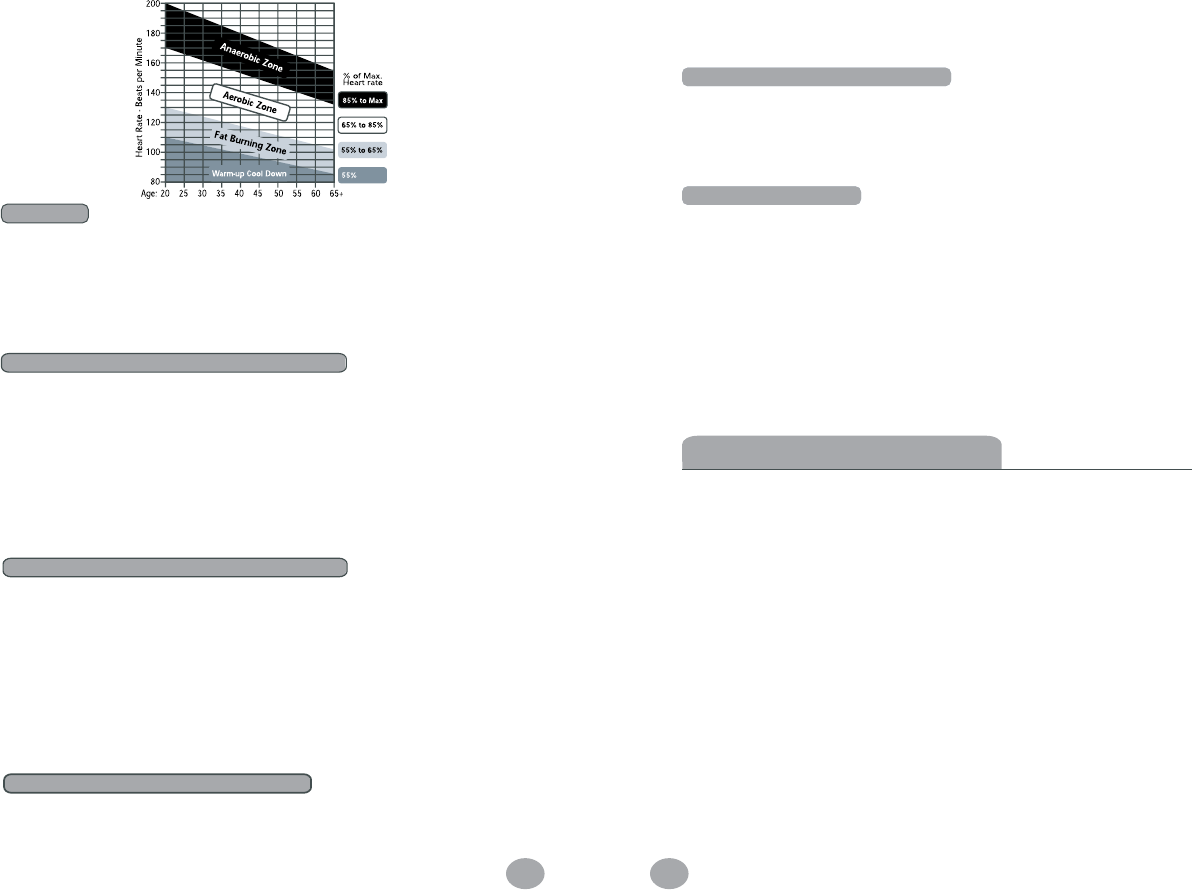
RH
xa
M
ot
%
5
8
:eno
Zc
i
bo
rean
Ae
hT
s
se
r
g
o
r
P
r
uoyrotinoM
.
92
03
g
ni
hct
er
t
S
xednItaeH
w
onK
o
tgnitteG2.3
Stretch at the beginning and end of every workout. Stretching before your workout
increases flexibility and helps prevent muscle strain or injury. Stretching after your
workout loosens tight muscles and helps prevent soreness.
• Stretch before warm up and after cool down.
• Stretch slowly and gently. Never bounce or stretch to a point of pain.
• Hold each stretch for 30-60 seconds and exhale as you extend into stretches.
Warm Up & Cool Down: 55% or Less of Max. HR
Begin and end every workout with a slow and gradual warm up and cool down,
respectively, Smoothly easing into and out of strenuous activity helps your body
prepare your metabolism and blood flow to efficiently break down fat and change
from one intensity level to another. Going into your Heart Rate Target Zone too
quickly can cause your heart rate to increase too rapidly. Rapid increase of the
heart rate could compromise consistent energy levels during a workout.
• Slowly bring your heart rate to a level just below the lower limit of your Heart
Rate Target Zone.
• Maintain your heart rate at this level for 5 to 10 minutes.
The Fat Burning Zone: 55%-65% of Max.HR
The Fat Burning Zone is recommended for those who are not in adequate physical
shape. This is the ideal zone for those who are beginning to exercise regularly,
would like to loose weight, and are at high risk for heart problems. It is intended
for low intensity and/or long duration exercise. Exercising at a lower intensity allows
for a longer, continuous exercising period. For weight loss and new exercise programs,
l
onger, continuous, low intensity workouts are safer and more beneficial. Slow and
steady wins the race!
• Duration: Build up gradually to 30 to 60 minutes per workout.
• Frequency: Workout 3 or 4 times per week.
The Aerobic Zone: 65%-85% of Max. HR
The Aerobic Zone is recommended for those in good physical condition who
have been exercising on a consistent basis for an extended period of time.
Exercising at this range helps improve your fitness level and prevent injury
from excessive training.
• Duration: 20 to 30 minutes per workout.
• Frequency: At least 3 or 4 times per week.
The Anaerobic Zone is ONLY recommended for to professional athletes or
those in exception physical condition. This zone can also be used for interval
training (high intensity for short durations) to help enhance overall strength and
endurance.
Heart rate fluctuations during physical activity can be tracked and documented
to determine overall health and fitness progress. As the cardiovascular system
becomes stronger, the resting heart rate will decrease. It will require more intensive
physical activity to reach the target zone and less time for the heart rate to recover.
Higher than usual resting heart rate and slower than usual heart rate recovery
could be an indication of strain of the heart from strenuous exercise or dehydration.
Resting for a day, lower intensity exercising, and replenishing the body with fluids
are advised. If your heart rate activity does not return to normal, please consult
a doctor.
The Heat Index combines the effects of heat and humidity. When heat and
humidity combine to reduce the amount of evaporation of sweat from the body,
outdoor exercise becomes dangerous even for those in good physical condition.
Key rules for coping with heat are to drink plenty of water to avoid dehydration,
slow down, and cool off when feeling fatigued, headache, a high pulse rate or
shallow breathing. Overheating can cause serious, even life-threatening conditions
such as heat stroke. The Apparent Temperature, which combines the temperature
and relative humidity, is a guide to the danger. Below is the Heat Stress Index
based on the Apparent Temperature.


















